This sad story begins on July 29, 2020–the day I took the picture below.
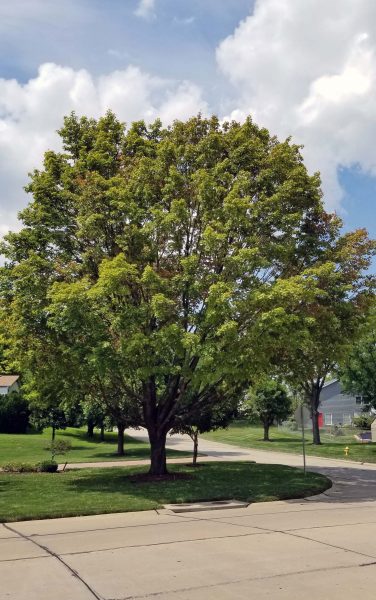
Ted and I noticed lots of leaves dropping from our sugar maple tree in July. When we looked up, we saw that the leaves on some of the branches were turning brown–not something we expected during mid-summer, especially with all the rain we’ve had this year. If you look closely at the picture above, you’ll see some of the leaves turning brown. I took a picture of the tree right away so I’d have a good memory of it before it got worse. So many leaves dropped so quickly (below), Ted had to rake the lawn before mowing it.
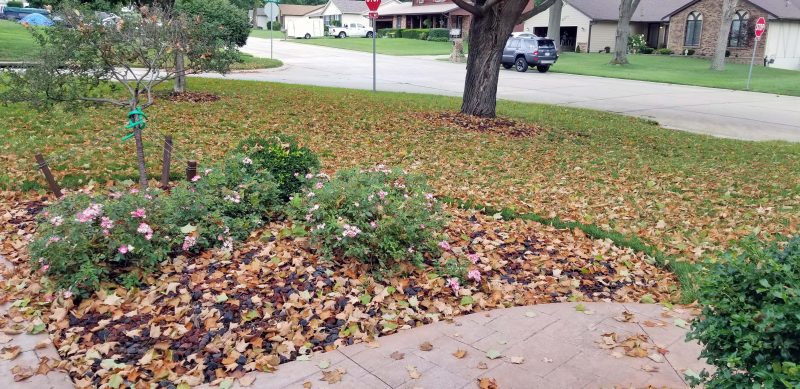
We called Russ, an arborist, who diagnosed the tree as fatally ill with a wilt disease and probably some weaknesses resulting from storm damage (ice, wind) several times over the years. While he was talking with us, leaves fell like large brown snowflakes. Russ said he’d never seen a tree deteriorate that fast. Because of all the tree removals he had already scheduled, Russ’s company couldn’t come until yesterday. I guess it isn’t my imagination that wherever I go this year, someone seems to be taking down mature trees.
The tree removal crew showed up right after 6:30 a.m. and got to work. They powered up the cherry-picker and Doug climbed in, took it up, and fastened pulleys in upper branches of the tree. Then he strung rope through the pulleys for the guys below to pull, guiding the branches safely down. (See the guy in the center of the picture.) Sometimes the guy pulling the rope would walk it around the tree’s trunk to wind it tighter and keep it from slipping when a large branch fell. Compare how the tree looks to only 35 days ago in the first picture.
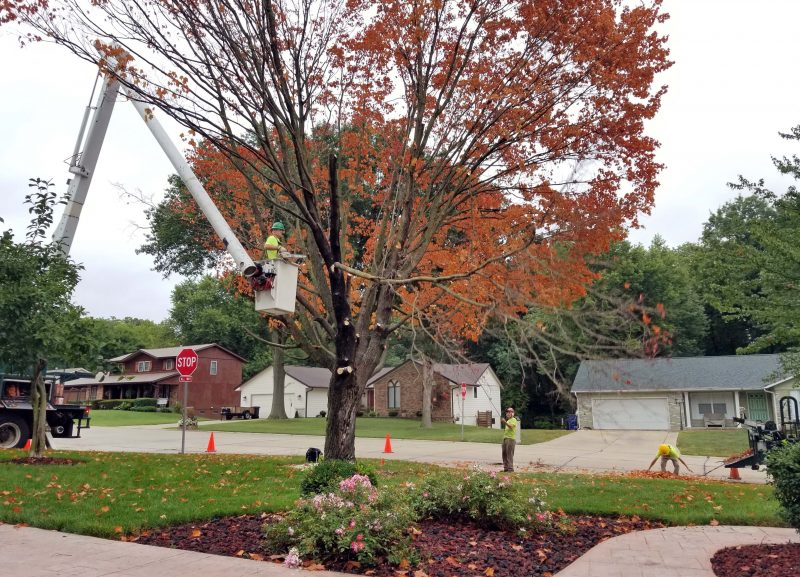
Notice what a pretty color the leaves have turned (below). I called the arborist two days ago to ask if there’s a chance the tree will live because it’s so nicely colored. Unfortunately, he said, that’s a definite sign it’s dying because the other maples in the area are not even beginning to show fall colors. As cut branches fell, the dead leaves created colorful showers.
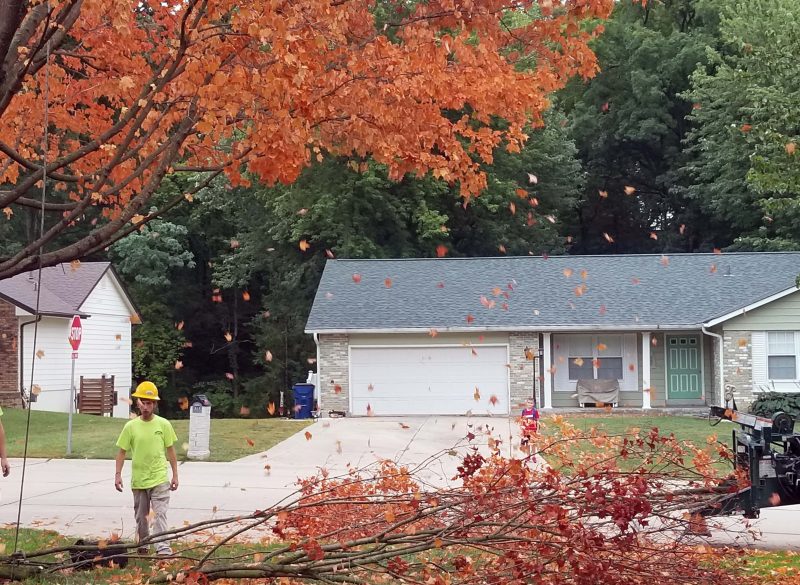
When the branches from the driveway side of the tree were stripped, one of the guys re-wound the rope in the rope-holder bucket. I wondered why he was doing that. Didn’t they need to use the rope to safely bring down the branches on the other two-thirds of the tree? They picked up some of the larger branches and laid them out as shown below. Ted suggested that maybe they were going to build a little fort. Instead, they sat on the branches and had a smoke break.
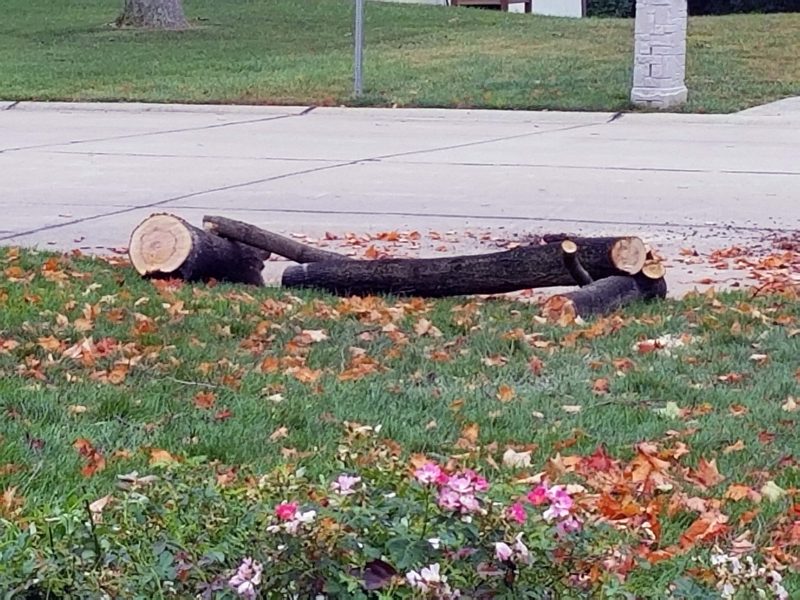
When Doug moved the traffic cones to block the street in front of the tree and then cut out a wedge at the base of the tree on the street side, the light dawned on me: they were planning to drop the rest of the tree across the street. They only cut off the other branches to avoid damage to our driveway and other plantings. Notice the split down the trunk where the tree twisted from wind storms and from the weight of ice storms over the years. In the picture below, Doug’s chainsaw is nearly all the way through the base of the trunk. Going . . . going . . . going . . .

Timberrrrrrrr!!!!

And it’s over. The log “fort” was a bridge to cushion the blow of the tree hitting the ground. I have to admit that I got a little bit choked up when the tree fell. This was one of the first of three trees we planted in our yard in 1980. At one point, for some unremembered reason, we talked about removing it, but Jeff pleaded with us to keep it because it was his favorite tree. Doug estimated the height of the tree at 50-55 feet. So sad.
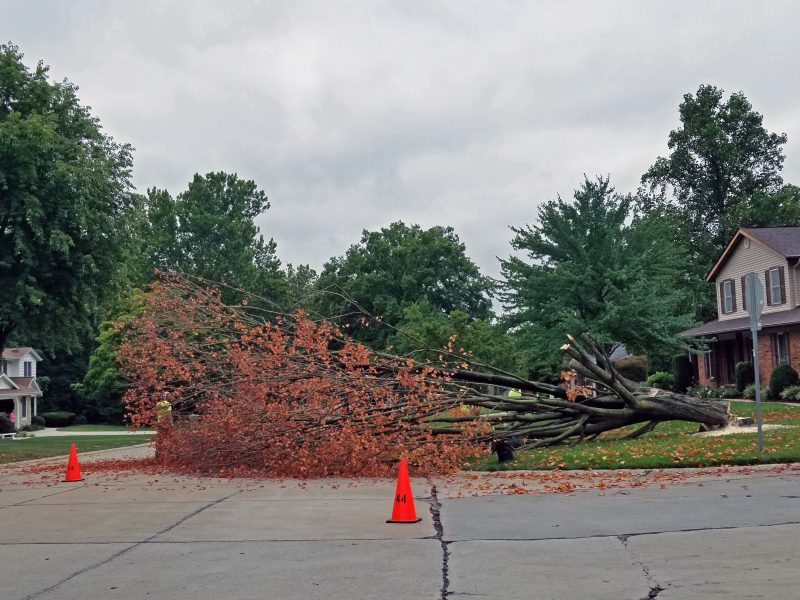
The tree also landed right on the wedge Doug cut. He told me that was unintentional.
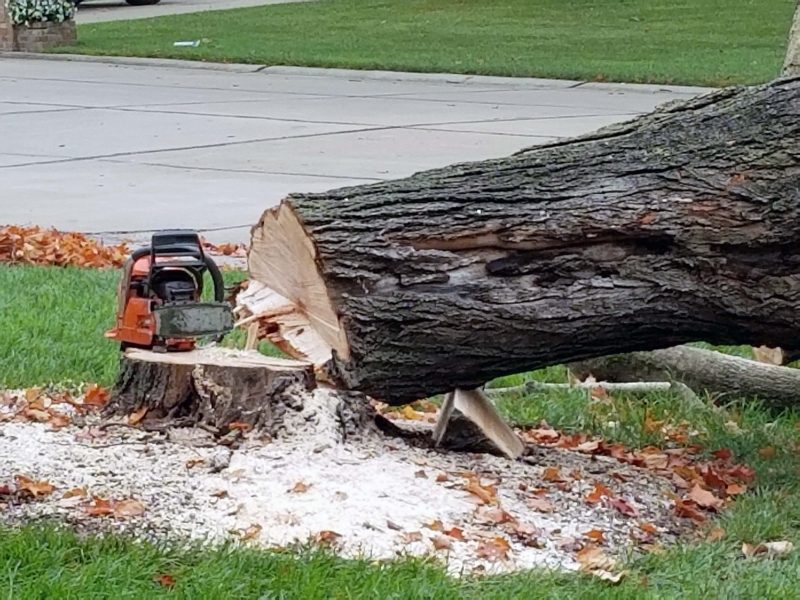
The guys got to work, cutting the fallen tree into manageable pieces, then hauling them to the mulcher. Doug, on the left, is the senior member of the team; the guy on the right is the junior member. He wasn’t allowed to use a chainsaw and was limited to picking up branches, feeding them into the mulcher, re-winding the rope, raking leaves, etc. The guy in the middle helped with everything except getting into the cherry picker bucket.
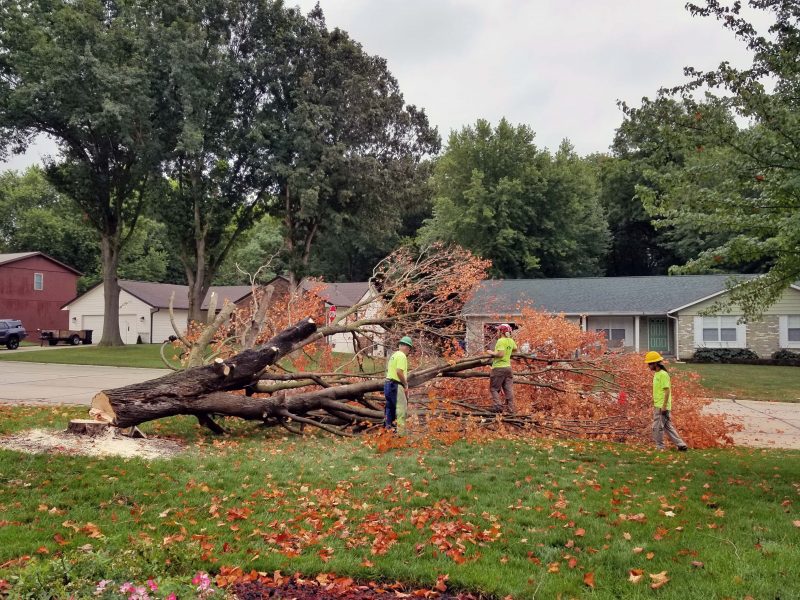
Things were going well until they weren’t. Doug smelled diesel fuel and found a leak in the pump line. The guys shut down the mulcher and had a little conference. Turning off the motor stopped the leak. It also stopped the work. The crew quickly covered the leaked fuel with sawdust and leaves to absorb it. The two junior members of the crew took the mulcher back to home base to exchange it for a working model. That took about 90 minutes. Doug had to stay with the tree because it was still blocking the road and wasn’t completely cleaned up. (Safety and liability, I assume.) You can see the pile of leaves and sawdust in the road. It looks inert, but it’s busily absorbing diesel fuel.
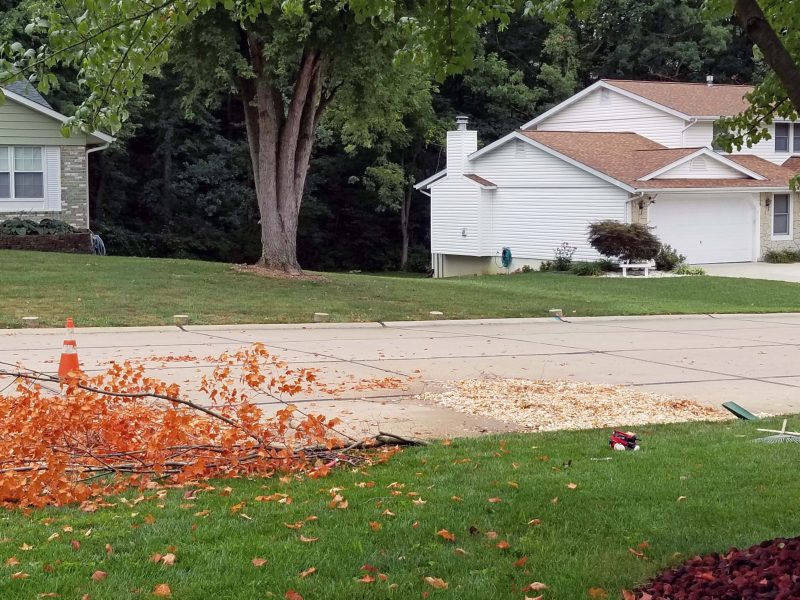
Break time while we wait for a different mulcher.

Our lilac tree also died this year and Ted recently uprooted it. I asked Doug if he’d mind running the lilac tree through his mulcher. He told us to bring it out. It looks so small compared to the sugar maple.
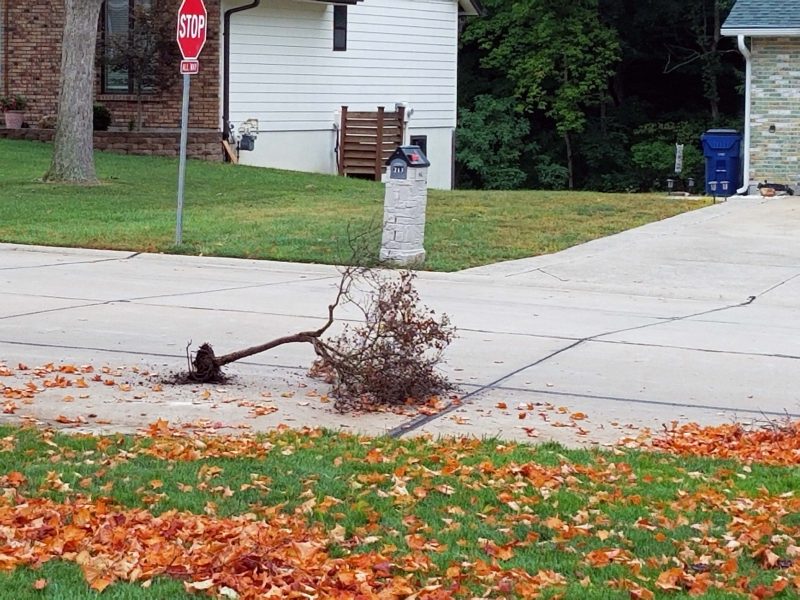
While waiting for the replacement mulcher, Doug got to work on the magnolia tree. Because it grew in the shadow of the sugar maple, the side next to the sugar maple didn’t fill out as well as the side next to the driveway. Doug evened it out. He took the cherry picker up for a bird’s eye view of the tree’s shape and then he went to work.
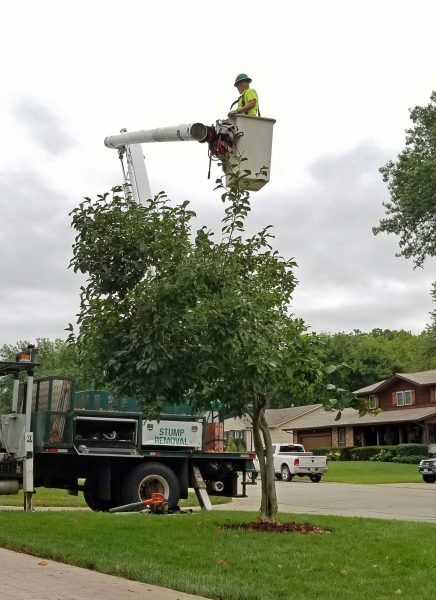
The tree is smaller now and Doug said it won’t bloom next year, but it should grow faster and more evenly since it now stands alone.

The clean-up work resumed when the guys came back with a working mulcher. They totally cleaned up our lawn and the street and even went across the street to clean up Jim’s lawn and driveway where a lot of leaves had fallen.

When they left, this is all we had of the tree. They told us the crew with the forklift would probably arrive later today, and definitely this week. They were here in less than 30 minutes.
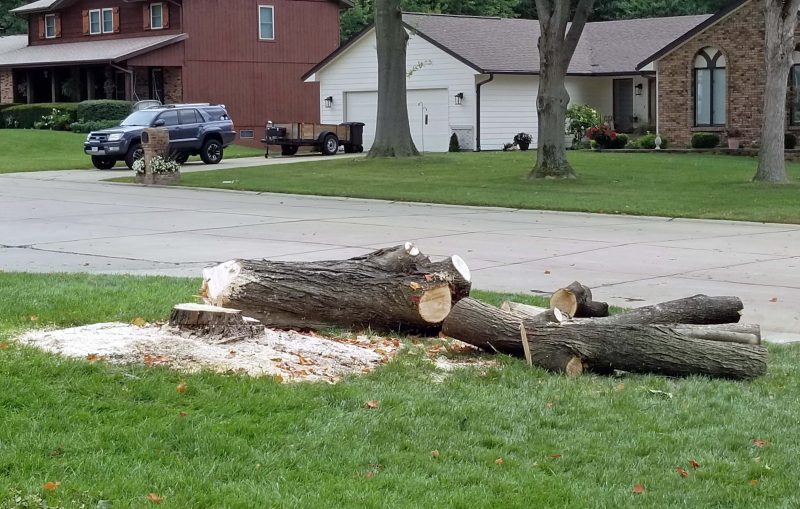
The tree company has a good thing going. Their trucks advertise that they also sell firewood and mulch. They charged us to take down the tree, then they took away a truckload of mulch from shredding all the branches, and now they’re taking away big logs that will make firewood for them to sell. It’s kind of a commercial version of The Giving Tree. Hopefully, this contributes to reducing the cost of tree removal.
Here goes some of the firewood-to-be on the forklift. Up on the fork, then down into the truck.

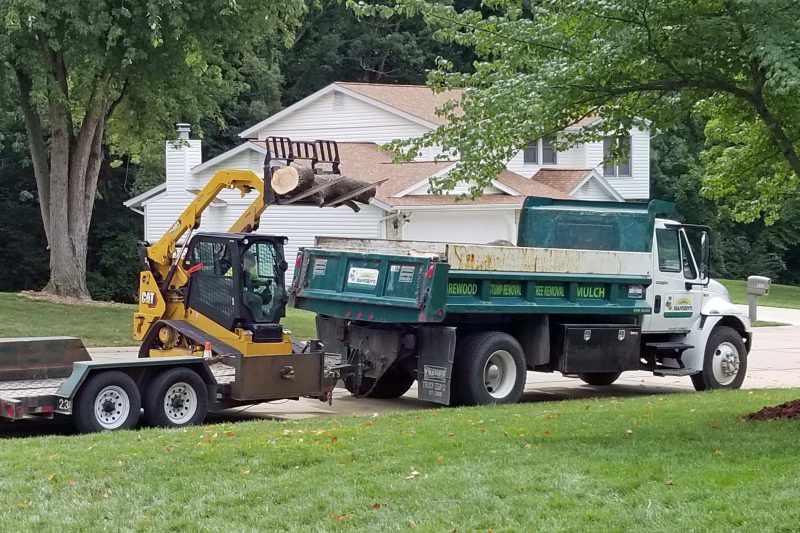
The guys cut the stump lower for grinding (stump grinder approaching from the left) and that’s when I saw what an interesting shape the tree trunk had.
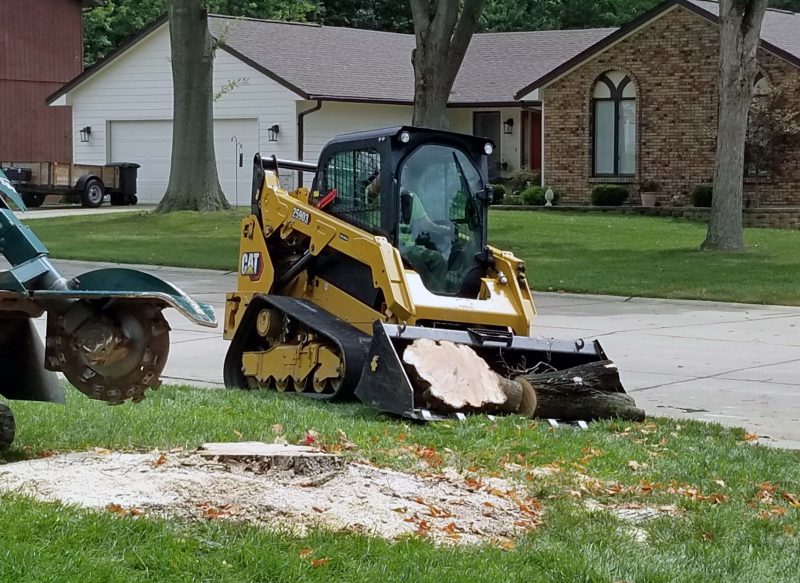
The stump grinder guy needs lots of patience. The equipment moves very slowly into position. The blade is speedy, but he has to move it slowly over the upper edge of the trunk, then slowly back, then drop it a bit, and then repeat–over and over until he gets all the way through the stump. It took him about 30 minutes to grind our stump. It looked like a boring, but dangerous job. When he finished, he very slowly directed the machine back to his truck.
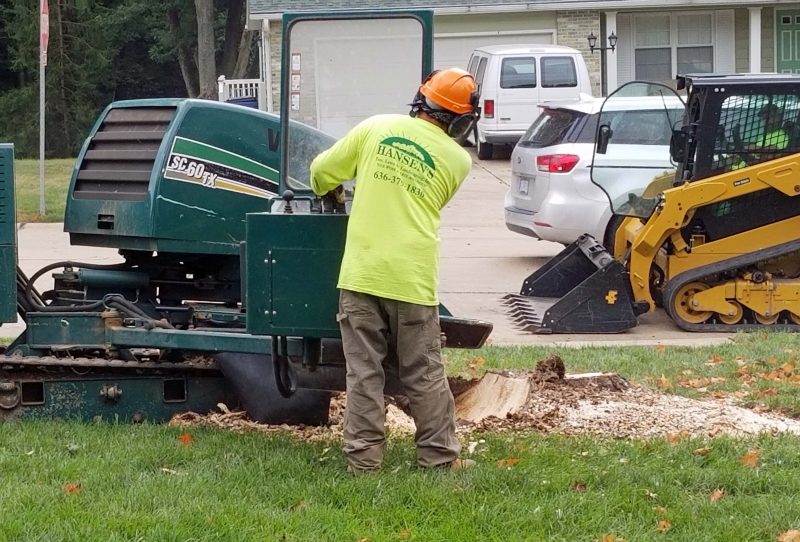
The forklift returned to the scene of the damage to pick up the piles of mulch created by the stump grinder. From the stump, into the truck, and then for sale as mulch.


The guys raked everything smooth before they left. You can see our neighbor, Jim, watching the fun from his garage.
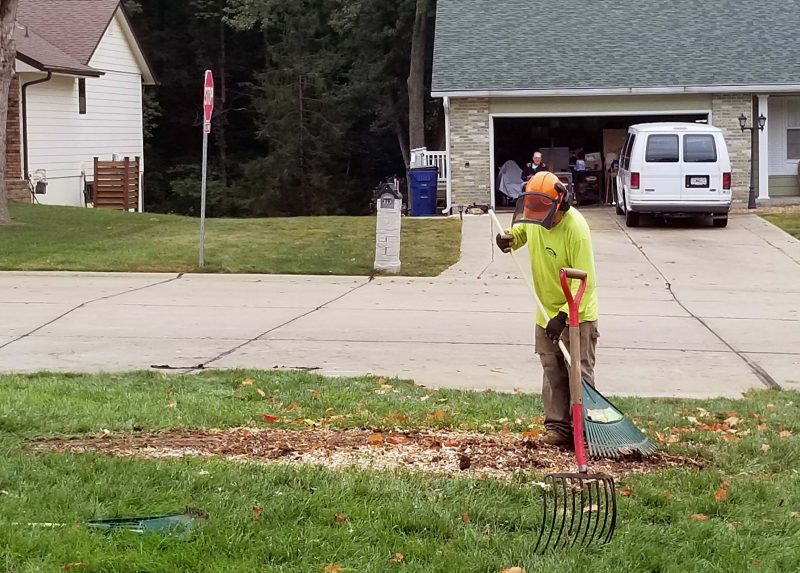
When the yard, the street, and the neighbors’ yards were clean, the crews left this for us.
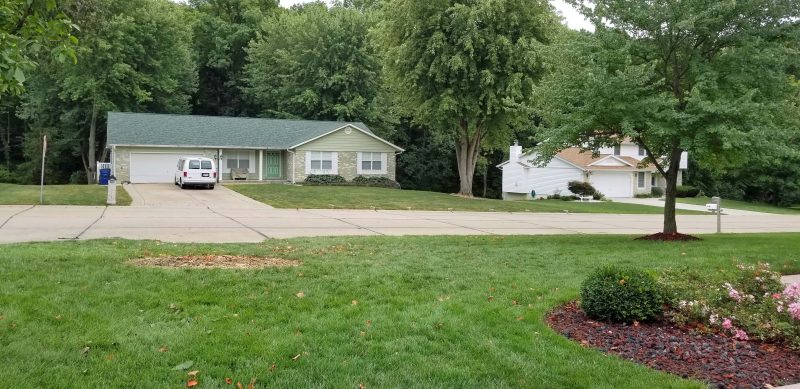
Here’s our new look.

While the tree crews were working, Ted and I were sitting in the driveway watching them. Neighbors and strangers stopped to tell us how sorry they were to see this tree go. Several mentioned what a beautiful tree it was and how much they’ve enjoyed it every fall. One lady even said she always thought the fall colors of the tree perfectly complemented our house. After 40 years of watching our sugar maple grow and turn color, we’ll never see it again. I’m glad I took this October picture last year.
